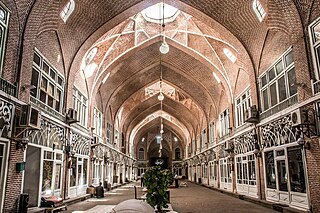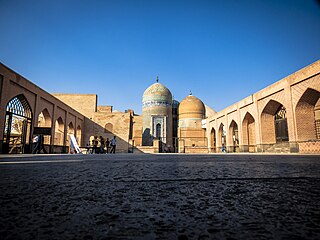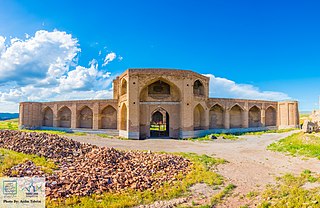Background

Caravanserais were roadside inns, which would provide shelter to travelers. [3] [4]
| UNESCO World Heritage Site | |
|---|---|
| Criteria | (ii)(iii) |
| Reference | 1668 |
The Persian Caravanserai is a UNESCO World Heritage site composed of 54 different caravanserais. [1]
It was inscribed in 2023. [2]

Caravanserais were roadside inns, which would provide shelter to travelers. [3] [4]
| ID (UNESCO) | Image | Name | Province |
|---|---|---|---|
| 1668-001 |  | Deyr-e Gachin | Qom |
| 1668-002 |  | Noushirvān | Semnan |
| 1668-003 |  | Āhovān | Semnan |
| 1668-004 |  | Parand | Tehran |
| 1668-005 |  | Robāt-e Sharaf | Razavi Khorasan |
| 1668-006 | Anjireh Ājori | Yazd | |
| 1668-007 | Anjireh Sangi | Yazd | |
| 1668-008 |  | Abbās Ābād Tāybād | Razavi Khorasan |
| 1668-009 |  | Jamāl Ābād | East Azerbaijan |
| 1668-010 | Qelli | North Khorasan | |
| 1668-011 |  | Fakhr-e Dāvūd | |
| 1668-012 |  | Sheikhali Khān | |
| 1668-013 |  | Maranjāb | |
| 1668-014 |  | Amin Ābād | |
| 1668-015 | Gabr Ābād | ||
| 1668-016 | | Mahyār | |
| 1668-017 |  | Gaz | |
| 1668-018 | Kūhpāyeh | ||
| 1668-019 |  | Mazinān | |
| 1668-020 |  | Mehr | |
| 1668-021 |  | Zafarāniyeh | |
| 1668-022 | Fakhr Ābād | ||
| 1668-023 | Sarāyān | ||
| 1668-024 |  | Qasr-e Bahrām | |
| 1668-025 |  | Mayāmey | |
| 1668-026 |  | Abbās Ābād | |
| 1668-027 |  | Miāndasht | |
| 1668-028 |  | Zeynoddīn | |
| 1668-029 |  | Meybod | |
| 1668-030 |  | Farasfaj | |
| 1668-031 |  | Īzadkhāst | |
| 1668-032 |  | Bisotūn | |
| 1668-033 |  | Ganjali Khān | |
| 1668-034 |  | Yengeh Emām | |
| 1668-035 |  | Khājeh Nazar | |
| 1668-036 | Goujebel | ||
| 1668-037 |  | Sāeen | |
| 1668-038 |  | Titi | |
| 1668-039 | Dehdasht | ||
| 1668-040 | Khoy | ||
| 1668-041 | Bāgh-e Sheikh | ||
| 1668-042 | Neyestānak | ||
| 1668-043 | Chehel Pāyeh | ||
| 1668-044 |  | Khān | |
| 1668-045 | Deh Mohammad | ||
| 1668-046 |  | Tāj Ābād | |
| 1668-047 |  | Chāh kūrān | |
| 1668-048 |  | Kharānaq | |
| 1668-049 |  | Rashti | |
| 1668-050 |  | Borāzjān | |
| 1668-051 | Chameshk | ||
| 1668-052 |  | Afzal | |
| 1668-053 |  | Bastak | |
| 1668-054 |  | Saʿadossaltaneh |

Iran, officially the Islamic Republic of Iran (IRI) and also known as Persia, is a country in West Asia. It borders Turkey to the northwest and Iraq to the west, Azerbaijan, Armenia, the Caspian Sea, and Turkmenistan to the north, Afghanistan to the east, Pakistan to the southeast, the Gulf of Oman and the Persian Gulf to the south. With a multi-ethnic population of about 86 million in an area of 1,648,195 km2 (636,372 sq mi), Iran ranks 17th globally in both geographic size and population. It is the sixth-largest country entirely in Asia and one of the world's most mountainous countries. Officially an Islamic republic, Iran has a Muslim-majority population. The country is divided into five regions with 31 provinces. Tehran is the nation's capital, largest city and financial centre.

The Golestan Palace, also transliterated as the Gulistan Palace and sometimes translated as the Rose Garden Palace from Persian language, was built in the 16th century, renovated in the 18th century and finally rebuilt in 1865. It is the former official royal Qajar complex in Tehran.

Qom province is one of the 31 provinces of Iran with 11,237 km², covering 0.89% of the total area of the country. Its capital is the city of Qom.

A bazaar or souk is a marketplace consisting of multiple small stalls or shops, especially in the Middle East, the Balkans, Central Asia, North Africa and South Asia. They are traditionally located in vaulted or covered streets that have doors on each end and served as a city's central marketplace.

A caravanserai was a roadside inn where travelers (caravaners) could rest and recover from the day's journey. Caravanserais supported the flow of commerce, information, and people across the network of trade routes covering Asia, North Africa and Southeast Europe, most notably the Silk Road. Often located along rural roads in the countryside, urban versions of caravanserais were also historically common in cities throughout the Islamic world, and were often called other names such as khan, wikala, or funduq.

The Bazaar of Tabriz is a historic market in central Tabriz, Iran. It is one of the oldest bazaars in the Middle East and the largest covered bazaar in the world. It is one of Iran's UNESCO World Heritage Sites.

Iranian architecture or Persian architecture is the architecture of Iran and parts of the rest of West Asia, the Caucasus and Central Asia. Its history dates back to at least 5,000 BC with characteristic examples distributed over a vast area from Turkey and Iraq to Uzbekistan and Tajikistan, and from the Caucasus to Zanzibar. Persian buildings vary greatly in scale and function, from vernacular architecture to monumental complexes. In addition to historic gates, palaces, and mosques, the rapid growth of cities such as the capital Tehran has brought about a wave of demolition and new construction.

Meymand is a village in, and the capital of, Meymand Rural District of the Central District of Shahr-e Babak County, Kerman province, Iran.

Tourism in Iran provides a range of activities from hiking and skiing in the Alborz and Zagros mountains, to beach holidays by the Persian Gulf and the Caspian Sea. The Iranian government has made efforts to attract tourists to various destinations in the country.

Izadkhast is a city in the Central District of Abadeh County, Fars province, Iran, and serves as the administrative center for Izadkhast Rural District. It is the first city in Fars on the Isfahan-Shiraz Highway.

Sheikh Safi al-Din Khānegāh and Shrine Ensemble is the tomb of Sheikh Safi-ad-din Ardabili located in Ardabil, Iran. In 2010, it was registered on the UNESCO World Heritage List.

Mehriz is a city in the Central District of Mehriz County, Yazd province, Iran, serving as capital of both the county and the district. It lies along the transit highway connecting Bandar Abbas to Tehran, and it marks the beginning of the highway under construction from Mehriz to Neyriz.

The Complex of Izadkhast is located in Izadkhast in the Fars Province of Iran, roughly 135km south of Isfahan. It is a historical complex listed in the UNESCO World Heritage Tentative List. The complex consists of the Izad-khast Castle and old ruined town, the Izadkhast Caravanserai roadside inn, and a Safavid-period bridge. The complex is located on a natural base with the castle built on a bedrock to protect it from foreign attacks. The architecture of the complex displays unique characteristics to Izadkhast.

The Izad Khast Castle is located in Izadkhast in the Fars province, central Iran. The castle was built during the Sassanid Empire and functioned as fortified walled city on the ancient Silk Road that ran through central Iran. It is the second largest adobe building in the world after Arg-e Bam.

The Izadkhast Caravanserai is a historic site located in Izadkhast in Fars Province, central Iran. It was a caravanserai or roadside inn on the ancient Silk Road, serving caravaners and travelers as a place for rest and recovery during long journeys. It is situated in the historical complex of Izadkhast, lying in a natural low basin looking onto the Izadkhast Castle situated in the nearby high bedrock. Its construction dates to the early 17th century during the reign of Shah Abbas.
Yengi Emam Caravansari is located in Alborz Province in the hills of Yengi Emam. The caravansary is considered an important site for Persian architecture that evolved in the Silk Road. The building dates to the 17th century.

Jamalabad Caravanserai is a historical caravanserai in Jamalabad, near Mianeh, Iran. The building was originally constructed in Ilkhanate era, but was repaired during the reign of Abbas II.

Sarayan Caravanserai is a caravanserai located in the city of Sarayan in Iran.